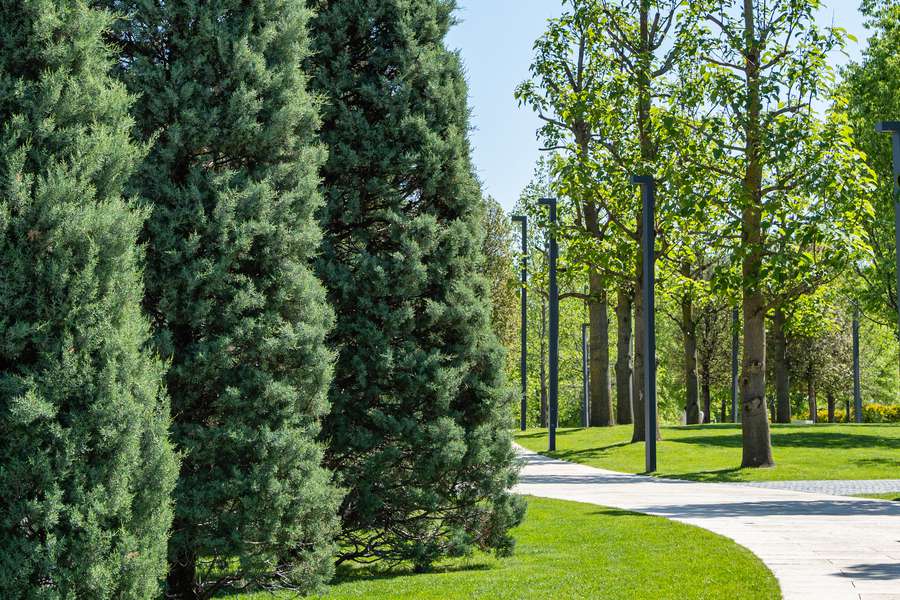Growing evergreen trees on your property provides beauty to your landscape, shade in the hotter months, and habitat and sometimes food sources for birds and
pollinators
throughout the seasons. Evergreen trees have foliage throughout the year so you won’t have a bare tree in the cooler months or have to rake up piles and piles of leaves. Many
fast-growing
evergreen trees serve as a natural privacy screen.
Tips For Growing Fast-Growing Evergreens
Choosing trees to grow in your landscape requires considerations about space and care requirements. Know the height and width of the tree at maturity to ensure there is ample space as it grows. Care requirements need to be carefully considered to avoid planting a tree in a shaded area when it needs full sun. “Research the tree’s planting requirements, including sun exposure, soil type, and drainage needs,” says
Mt. Cuba’s
Manager of Horticultural Research, Sam Hoadley. “This will provide your tree with optimal conditions for its longevity and good health.”
Most evergreens need ample sunlight. “Full sun is best for most evergreens, so plant them in a location that receives at least six to eight hours of direct sunlight per day,” says Rhonda Kaiser, author of
The Vintage Farmhouse Garden
and owner of
Southern Home and Farm
.
Consider these expert picks for fast-growing evergreen trees.
Atlantic White Cedar
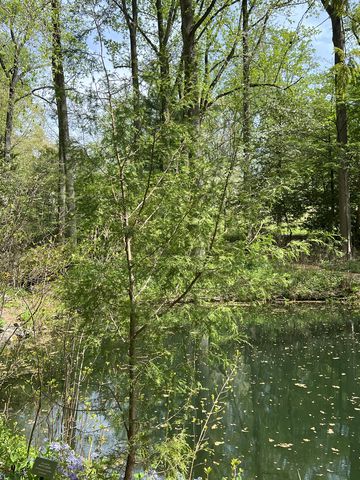
The Atlantic White Cedar, also called Swamp Cedar,
Chamaecyparis thyoides
, because it thrives near swamp areas and likes wet soil. These trees have “scale-like leaves that range in color from greens to waxy blues,” says Hoadley, “And produces clusters of small spherical cones at the ends of its branches that add additional interest and texture to this incredible evergreen tree.”
-
Botanical Name:
Chamaecyparis thyoides
-
Sun Exposure:
Full, partial -
Soil Type:
Moist to wet -
Soil pH:
Acidic to slightly alkaline (4.0 to 6.0)
Blue Ice Cypress
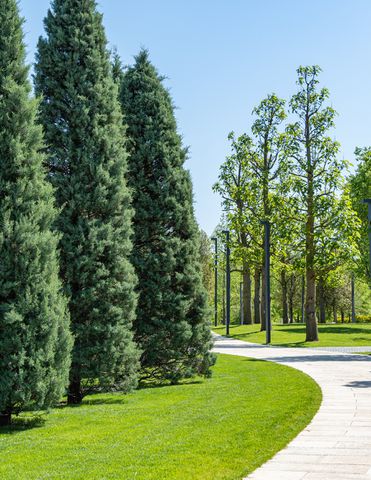
Grow Blue Ice Cypress,
Cupressus arizonica
‘Blue Ice,’ if you’re looking for a natural way to create more privacy on your property and want to use less water in the garden. “One of the most drought-tolerant evergreens, it features attractive silvery-blue foliage year-round, which adds unique color to the landscape,” says Kaiser. These trees are low-maintenance as long as their care needs are met with adequate sun, soil and nutrients.
-
Botanical Name:
Cupressus arizonica
‘Blue Ice’ -
Sun Exposure:
Full -
Soil Type:
Well-drained, Loamy, Clay, Sand -
Soil pH:
Slightly Acidic to Neutral (6.0-7.0)
Eastern Red Cedar
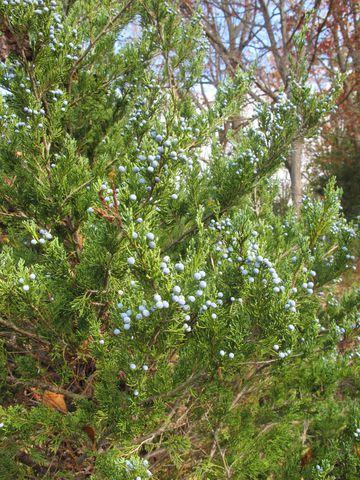
Eastern Red Cedars, also known as Eastern Juniper, are hardy trees that have dark green to light blue foliage. “Eastern red cedars are incredibly adaptable and fast-growing evergreen trees that thrive even in the harshest of conditions and still provide beauty and value to landscapes,” says Hoadley. Want to attract birds to your yard? Female trees produce berry-like cones that are a food source for many species of birds, he says. According to Kaiser, “It’s very easy to grow since it’s drought and salt-tolerant, making it low-maintenance.”
-
Botanical Name:
Juniperus virginiana
-
Sun Exposure:
Full, partial -
Soil Type:
Moist, Well-draining -
Soil pH:
Acidic to slightly alkaline (4.7 to 7.8)
Loblolly Pine
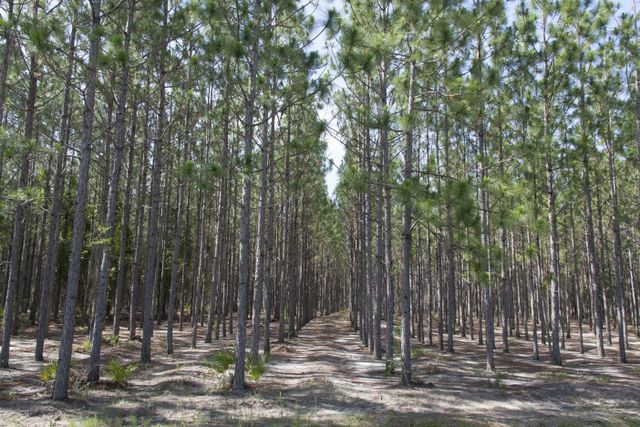
Loblolly pine is a native to the Southern United States. This tree often grows in groups in specific areas, known as large stands, says Hoadley. “When it is grown as a single specimen, the grace majesty of this species’ tall columnar trunks, scaley plated bark, and large sounded canopies becomes ever more apparent,” he says. This is one of Kaiser’s favorite trees for the shade and beauty it brings to the landscape.
-
Botanical Name:
Pinus taeda
-
Sun Exposure:
Full -
Soil Type:
Well-drained, Loamy -
Soil pH:
Acidic to Neutral (4.5.-7.0)
Southern Magnolia

Southern Magnolia is a native Southeastern tree that has big, leathery foliage. “Its large, glossy evergreen leaves offer year-round interest,” says Kaiser, “while its fragrant white flowers bloom in spring and even sporadically through summer, making it a standout in any southern landscape.”
Southern Magnolia can reach great heights, often between 50- 90 feet tall, according to the
USDA plant guide
. Choose compact varieties, such as ‘Teddy Bear’ and ‘Little Gem,’ says Hoadley, if space is a concern. And if you’re in a region with colder winter temperatures, choose southern magnolias that can tolerate the cold. He suggests ‘Bracken’s Brown Beauty’ and ‘Edith Bogue.’
They also double as a natural layer of privacy for your home. “Southern Magnolia can grow at a relatively fast pace, making it a viable choice for privacy screens,” says Hoadley.
-
Botanical Name:
Magnolia grandiflora
-
Sun Exposure:
Full, Partial -
Soil Type:
Well-drained, Moist, Loamy, Clay, Rich -
Soil pH:
Acidic (5.0-6.0)
Sweet Bay Magnolia
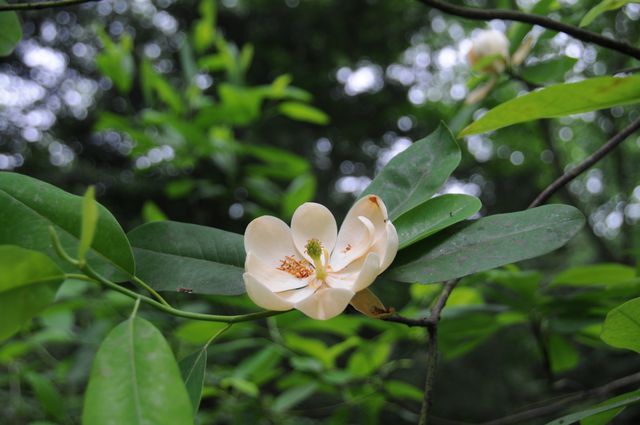
A southern variety of Sweet Bay Magnolia is
Magnolia virginiana
var.
australis
that grows in coastal areas. These varieties can grow taller than northern species, which tend to be smaller trees, says Hoadley. In the spring and summer, Sweet Bay Magnolia produces fragrant white flowers that attract pollinating insects, he says.
-
Botanical Name:
Magnolia virginiana
var.
australis
-
Sun Exposure:
Full -
Soil Type:
Well-drained, Loamy -
Soil pH:
Acidic to Neutral (5.5.-7.0)
Related:
The 12 Best Fast-Growing Evergreen Shrubs, According To Experts
Read the original article on
Southern Living

